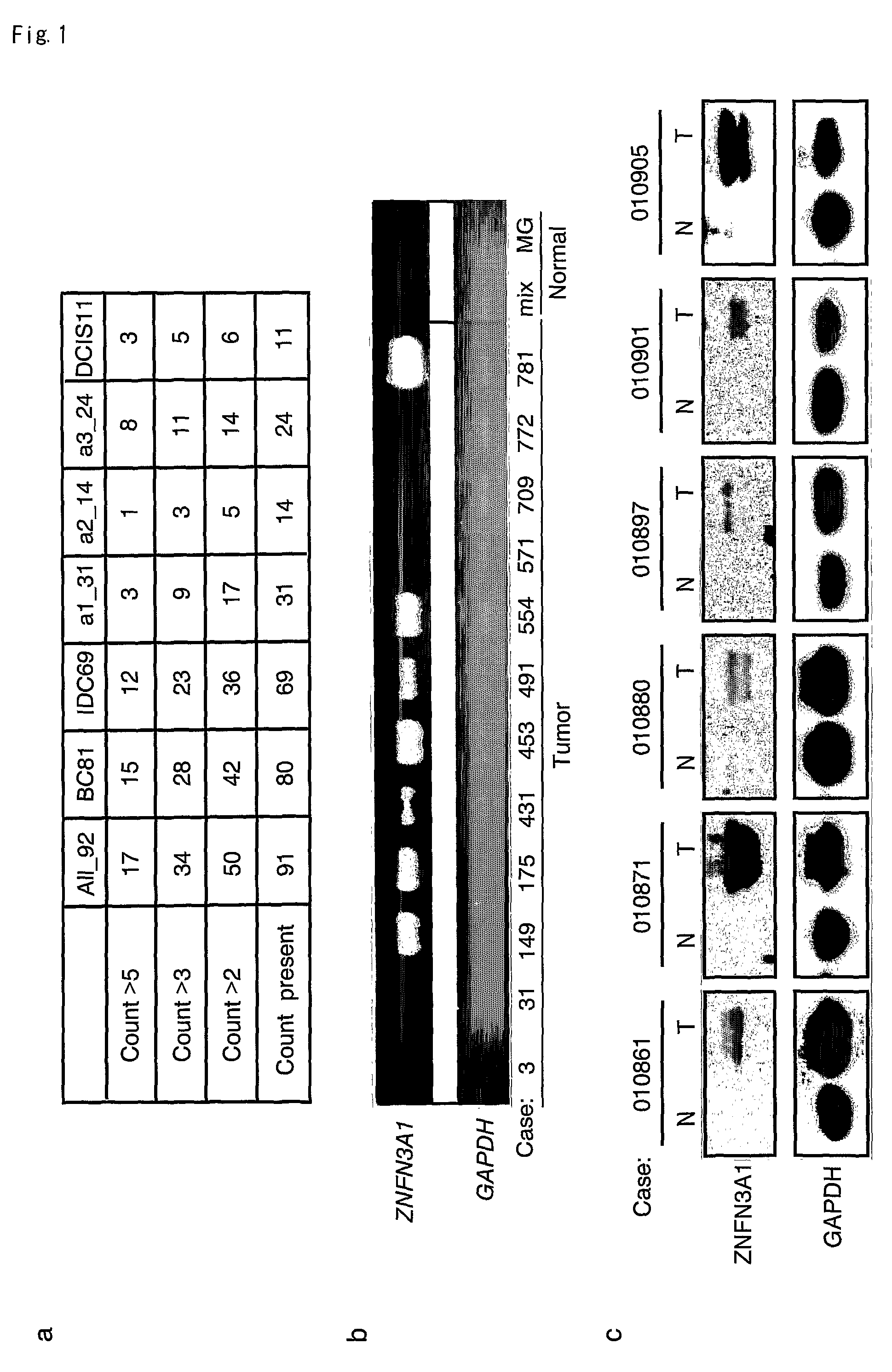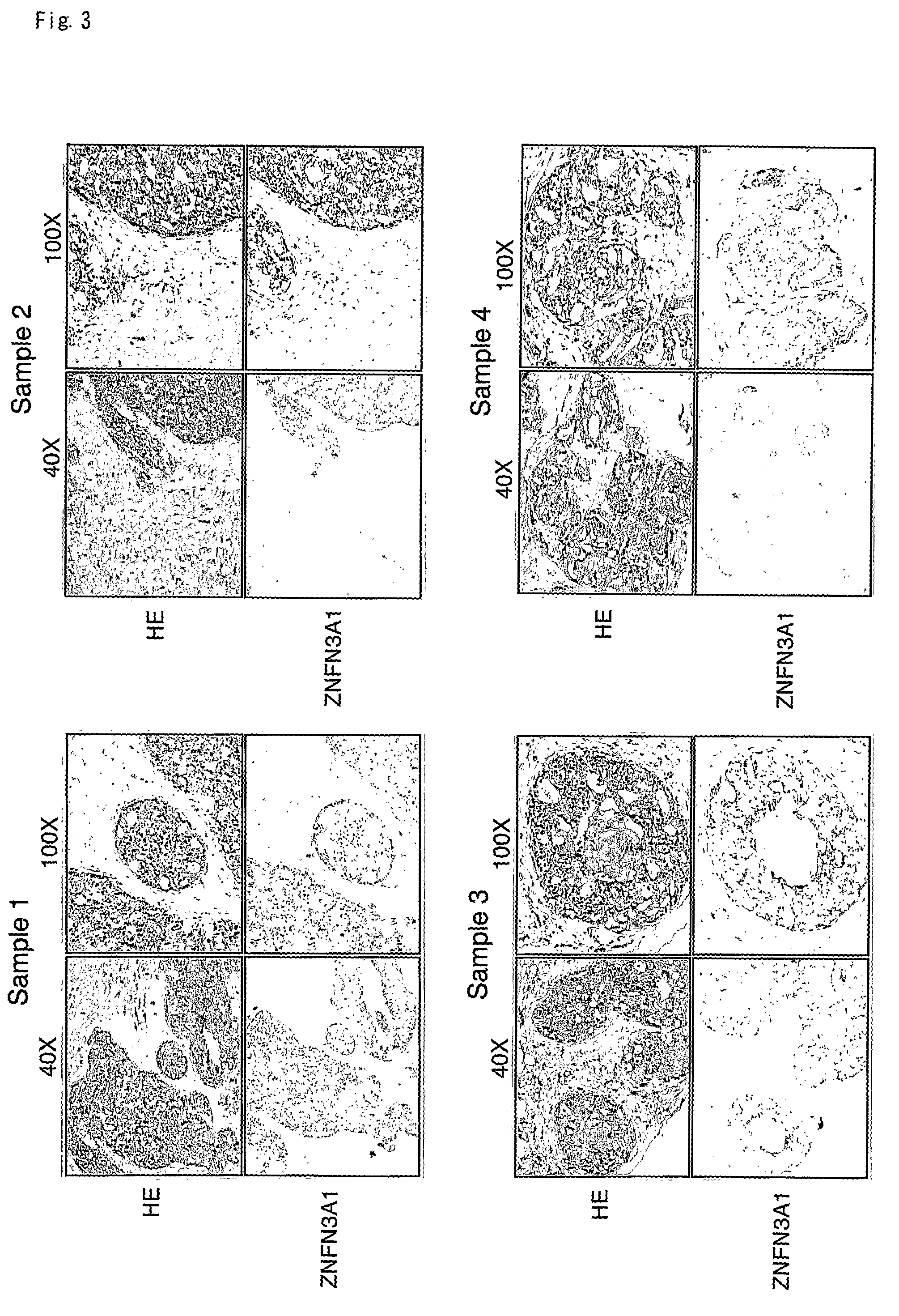Breast cancer related gene ZNFN3A1
a breast cancer and related gene technology, applied in the field of breast cancer related gene znfn3a1, can solve the problems of mass, insufficient reflection of the expressional changes that arise, and relapse at local or distant sites
- Summary
- Abstract
- Description
- Claims
- Application Information
AI Technical Summary
Benefits of technology
Problems solved by technology
Method used
Image
Examples
example 1
Enhanced ZNFN3A1 Expression in BRC
[0171]The global gene expression profile data obtained from 92 breast carcinomas using cDNA-microarray revealed that ZNFN3A1 expression was elevated in 36 of 69 invasive ductal carcinomas (IDC) and in 6 out of 11 ductal carcinoma in situ (DCIS), when the cut-off of tumor to normal tissue ratio was greater than two (FIG. 1a). This elevation was confirmed in 7 out of 12 IDCs selected randomly using cDNA that were used for microarray by semi-quantitative RT-PCR, compared to normal mammary ductal cells (FIG. 1b). To investigate ZNFN3A1 protein expression in BRC tissues, western blot analysis was carried out using protein extract from six bulk BRC tissues and their corresponding non-cancerous mammary tissues. A significant accumulation of ZNFN3A1 was consistently found in the six tumor tissues (FIG. 1c).
[0172]Since all western blot analyses of ZNFN3A1 protein detected two bands at 43 and 45 kDa in size (FIG. 1c), the two forms of protein were further inv...
example 2
Growth Suppression of BRC Cells by ZNFN3A1 siRNA
[0174]To test whether suppression of ZNFN3A1 may result in the induction of apoptosis in BRC cells, a cell viability assay was carried out using the ZNFN3A1 siRNA-12 that effectively suppressed ZNFN3A1 expression in colon and liver carcinoma cells (see WO2004 / 076623, the entire contents of which is incorporated by reference herein). The oligonucleotides used for construction cZNFN3A1 siRNA expression vector (for target sequence of SEQ ID NO: 1) are as follows:
psiU6BX-ZNFN3A1-12, Forward: 5′-AACATCTACCAGCTGAAGGTGTTCAAGAGAC ACCTTCAGCTGGTAGATGTT-3′ (SEQ ID NO; 2),
Reverse: 5′-AACATCTACCAGCTGAAGGTGTCTCTTGAACACCTTCAGCTGGTAG ATGTT-31 (SEQ ID NO; 3).
[0175]Western blot analysis of ten BRC cell lines revealed that ZNFN3A1 was abundantly expressed in 8 out of 10 BRC cells such as BT-20, HBL-100, MDA-MB-231, MCF7 and T47D cells (FIG. 4a). MDA-MB-231, MCF7 and T47D cells were transfected with psiU6BX-ZNFN3A1-12, psiU6-Luciferase, or psiU6 (mock), c...
PUM
| Property | Measurement | Unit |
|---|---|---|
| weight | aaaaa | aaaaa |
| Tm | aaaaa | aaaaa |
| drug resistance | aaaaa | aaaaa |
Abstract
Description
Claims
Application Information
 Login to View More
Login to View More - R&D
- Intellectual Property
- Life Sciences
- Materials
- Tech Scout
- Unparalleled Data Quality
- Higher Quality Content
- 60% Fewer Hallucinations
Browse by: Latest US Patents, China's latest patents, Technical Efficacy Thesaurus, Application Domain, Technology Topic, Popular Technical Reports.
© 2025 PatSnap. All rights reserved.Legal|Privacy policy|Modern Slavery Act Transparency Statement|Sitemap|About US| Contact US: help@patsnap.com



